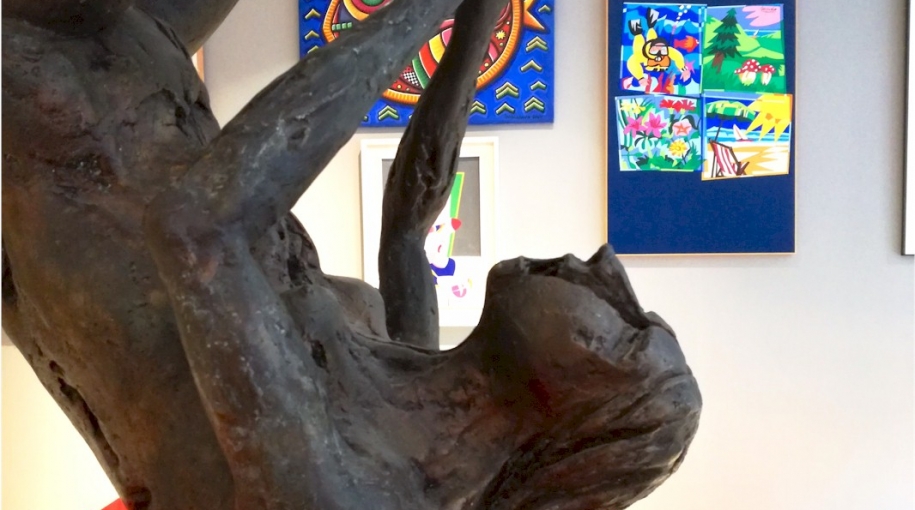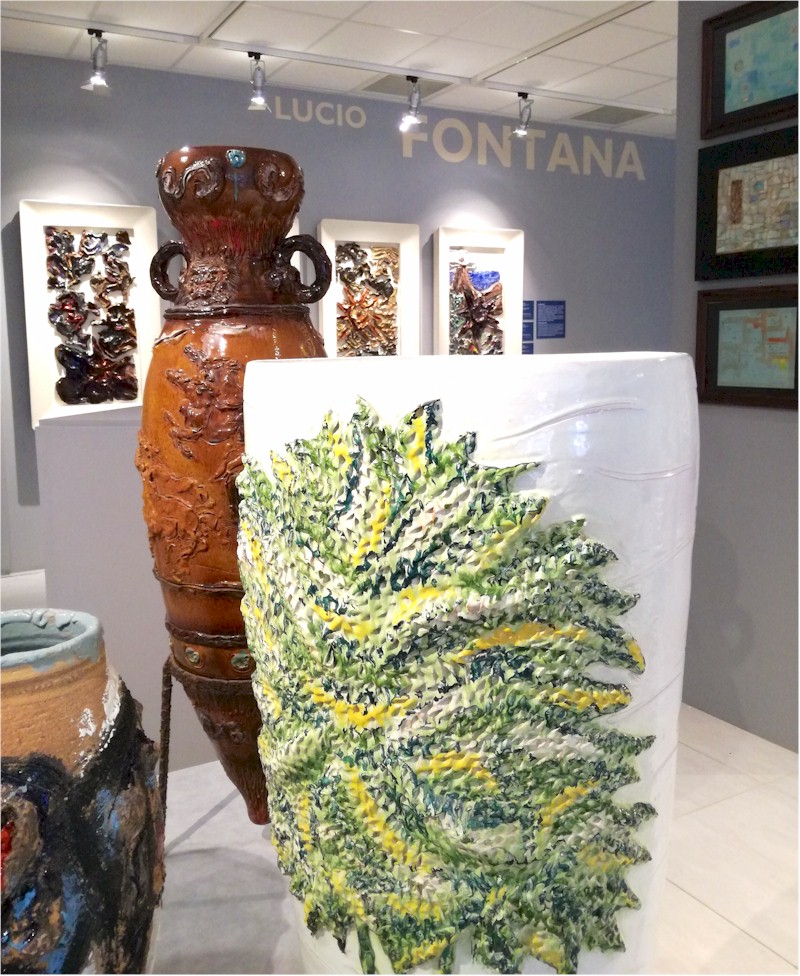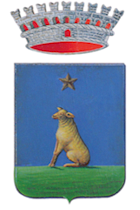At:
Via dell’Oratorio 2, 17012 Albissola Maria
HOURS
Tuesday to Sunday and holidays:
10.00-12.00 / 16.00 – 18.00
Mondays closed
CONTACT
Phone number: (+39) 019 400 2110
Email:
This email address is being protected from spambots. You need JavaScript enabled to view it.
This email address is being protected from spambots. You need JavaScript enabled to view it.
Modernity and Postmodernity in the civics collections of Albissola Marina
Curated by Luca Bochicchio
Exhibition Center from may 17, 2018
Curated by Luca Bochicchio
Exhibition Center from may 17, 2018
This exhibition collects very famous pieces, along with other less known, from the collection of Albissola Marina’s City Hall. The title is inspired by two highly symbolic figures in Western culture: Venus and the Owl. Both are represented in the civic collection, although, dating back to two distinct and significant historical moments: the late nineteenth century and the second half of the twentieth century.
The Venus (depicted according to the myth of her birth, among the sea waves) appears, in fact, in the ceramic sculpture made by Luigi Quaglino and Nicolò Poggi in 1898. The Civetta, instead, was interpreted by Pablo Picasso, in the Madoura edition of 1953, and by Roberto Crippa, in the painting of 1970 c.
Why can these two symbolic figures synthesize the idea of a comparison between Modernity and Postmodernity?
The collaboration between the Piedmontese painter Luigi Quaglino and the ceramist Nicolò Poggi from Albissola, historically marks the beginning of the production of artistic ceramics with a modern taste, between the nineteenth and twentieth centuries in Albissola. The sculpture The birth of Venus (1898), represents, as its best, this new modernist era, that sees Albissola, establishing itself on the international scene between the first and second half of the twentieth century, thanks to the experimentation in ceramics of the languages Liberty, Deco, Futurist, and later on, even those expressionist and informal.
Since ancient times, man has attributed to the owlet (as well as to the owl) multiple and contrasting ma-gical, sacred and symbolic meanings. In addition to representing wisdom (because of its ability to see and act even in the deepest darkness), the Owl has always alluded to the end of the day and therefore of life:
the end of the time of light and the beginning of that of darkness. In this exhibition, the owl modeled in ceramic by Picasso in Vallauris (South of France) in 1953, and especially that painted by Crippa in 1970 c., introduced us to the postmodern era, that starts with the end of the fifties and triumphs in the eighties and nineties of the twentieth century.
If Venus can be the metaphor for the birth of modernist culture in the early twentieth century, the Civetta (the owlet) embodies the passage to the postmodern era: that phase of history in which the modernist myth of renewal enters crisis, from the originality and progressive development of the arts.
The contamination between genres and artistic materials, the citation and the hybridization of cultural models "high" and "low", of the past and the present, come so to create, as we approach the end of the twentieth century, a visual and plastic panorama discontinuous, fluid and permeable.
In this exhibition we will meet authors’ works in which the postmodern spirit is well embodied (Loris Cecchini, Gianni Celano Giannici, Ugo La Pietra, Adriano Leverone, Sandro Lorenzini, Ugo Nespolo, Mario Rossello, Agostino Scrofani), others, who have interpreted the modernist spirit of the beginning of the century (Quaglino and Poggi, Manlio Trucco, the Futurists), and finally, those whohave been ferrymen of both
sensibilities (Edoardo Alfieri, Agenore Fabbri, Lucio Fontana, Ansgar Elde, Asger Jorn, Wifredo Lam, Picasso, Emilio Scanavino).
Why can these two symbolic figures synthesize the idea of a comparison between Modernity and Postmodernity?
The collaboration between the Piedmontese painter Luigi Quaglino and the ceramist Nicolò Poggi from Albissola, historically marks the beginning of the production of artistic ceramics with a modern taste, between the nineteenth and twentieth centuries in Albissola. The sculpture The birth of Venus (1898), represents, as its best, this new modernist era, that sees Albissola, establishing itself on the international scene between the first and second half of the twentieth century, thanks to the experimentation in ceramics of the languages Liberty, Deco, Futurist, and later on, even those expressionist and informal.
Since ancient times, man has attributed to the owlet (as well as to the owl) multiple and contrasting ma-gical, sacred and symbolic meanings. In addition to representing wisdom (because of its ability to see and act even in the deepest darkness), the Owl has always alluded to the end of the day and therefore of life:
the end of the time of light and the beginning of that of darkness. In this exhibition, the owl modeled in ceramic by Picasso in Vallauris (South of France) in 1953, and especially that painted by Crippa in 1970 c., introduced us to the postmodern era, that starts with the end of the fifties and triumphs in the eighties and nineties of the twentieth century.
If Venus can be the metaphor for the birth of modernist culture in the early twentieth century, the Civetta (the owlet) embodies the passage to the postmodern era: that phase of history in which the modernist myth of renewal enters crisis, from the originality and progressive development of the arts.
The contamination between genres and artistic materials, the citation and the hybridization of cultural models "high" and "low", of the past and the present, come so to create, as we approach the end of the twentieth century, a visual and plastic panorama discontinuous, fluid and permeable.
In this exhibition we will meet authors’ works in which the postmodern spirit is well embodied (Loris Cecchini, Gianni Celano Giannici, Ugo La Pietra, Adriano Leverone, Sandro Lorenzini, Ugo Nespolo, Mario Rossello, Agostino Scrofani), others, who have interpreted the modernist spirit of the beginning of the century (Quaglino and Poggi, Manlio Trucco, the Futurists), and finally, those whohave been ferrymen of both
sensibilities (Edoardo Alfieri, Agenore Fabbri, Lucio Fontana, Ansgar Elde, Asger Jorn, Wifredo Lam, Picasso, Emilio Scanavino).














